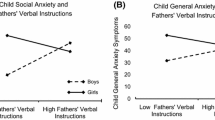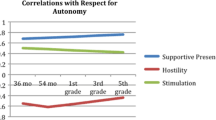Abstract
Differences in mother and father behavior during a triadic interaction session, and differences in mothers’ behavior across triadic and dyadic interaction, were examined in 60 two-parent families with an 11- to 15-month-old child (30 boys, 30 girls). Results revealed that mothers were less involved, less sensitive, and more negative during triadic than during dyadic interaction. Mothers of sons displayed more emotion during triadic interaction than mothers of daughters did. Mothers were more involved with children than fathers were during triadic interaction, whereas fathers displayed more emotion than mothers did during triadic interaction. Fathers were more supportive of mothers, and mothers were more intrusive toward fathers, during triadic interaction. The results are discussed in terms of the role that context plays in gender-typed patterns of family interaction.
Similar content being viewed by others
References
Allen, S. M., & Hawkins, A. J. (1999). Maternal gatekeeping: Mothers’ beliefs and behaviors that inhibit greater father involvement in family work. Journal of Marriage and the Family, 61, 199–212.
Beall, A. E. (1993). A social constructionist view of gender. In A. E. Beall & R. J. Sternberg (Eds.), The psychology of gender (pp. 127–147). New York: Guilford.
Belsky, J., Crnic, K., & Gable, S. (1995). The determinants of coparenting in families with toddler boys: Spousal differences and daily hassles. Child Development, 66, 629–642.
Belsky, J., & Hsieh, K. H. (1998). Patterns of marital change during the early childhood years: Parent personality, coparenting, and division-of-labor correlates. Journal of Family Psychology, 12, 511–528.
Belsky, J., & Volling, B. L. (1987). Mothering, fathering, and marital interaction in the family triad during infancy: Exploring family system processes. In P. W. Berman & F. A. Pederson (Eds.), Men’s transitions to parenthood: Longitudinal studies and early family experiences (pp. 37–63). Hillsdale, NJ: Erlbaum.
Blakemore, J. E., LaRue, A. A., & Olejnik, A. B. (1979). Sex-appropriate toy preference and the ability to conceptualize toys as sex-role related. Developmental Psychology, 15, 339–340.
Bronfenbrenner, U. (1986). Ecology of the family as a context for human development: Research perspectives. Developmental Psychology, 22, 723–742.
Buhrmester, D., Camparo, L., Christensen, A., Gonzalaz, L. S., & Hinsaw, S. P. (1992). Mothers and fathers interacting in dyads and triads with normal and hyperactive sons. Developmental Psychololgy, 28, 500–509.
Bussey, K., & Bandura, A. (1999). Social cognitive theory of gender development and differentiation. Psychological Review, 106, 676–713.
Caldera, Y. M. Huston, A. C., & O'Brien, M. (1989). Social interactions and play patterns of parents and toddlers with feminine, masculine, and neutral toys. Child Development, 60, 70–76.
Clarke-Stewart, K. A. (1978). And daddy makes three: The father’s impact on mother and child. Child Development, 49, 466–468.
Clarke-Stewart, K. A., Gruber, C. P., & Fitzgerald, L. M. (1994). Children at home and in day care. Hillsdale, NJ: Erlbaum.
Cowan, C. P., & Cowan, P. A. (1987). Men’s involvement in parenthood: Identifying the antecedents and understanding the barriers. In P. Berman & F. A. Pedersen (Eds.), Fathers’ transitions to parenthood (pp. 145–174). Hillsdale, NJ: Erlbaum.
Cox, M., Owen, M., Lewis, J., & Henderson, V. (1989). Marriage, adult adjustment, and early parenting. Child Development, 60, 1015–1024.
Crouter, A., Helms-Erikson, H., Updegraff, K., & McHale, S. (1999). Conditions underlying parents’ knowledge about children’s daily lives in middle childhood: Between- and within-family comparisons. Child Development, 70, 246–259.
Deaux, K., & Major, B. (1987). Putting gender into context: An interactive model of gender-related behavior. Psychological Review, 94, 369–389.
DeLuccie, M. F. (1996). Mothers: Influential agents in father–child relations. Genetic, Social, and General Psychology Monographs, 122, 285–307.
DeSalvo, F. J., & Zurcher, L. A. (1984). Defensive and supportive parental communication in a discipline situation. Journal of Psychology, 117, 7–17.
Fagot, B. I. (1974). Sex differences in toddlers' behavior and parental reaction. Developmental Psychology, 10, 554–558.
Floyd, F. J., & Zmich, D. E. (1991). Marriage and parenting partnership: Perceptions and interactions of parents with mentally retarded and typically developing children. Child Development, 62, 1434–1448.
Gjerde, P. F. (1986). The interpersonal structure of family interaction settings: Parent–adolescent relations in dyads and triads. Developmental Psychology, 22, 297–304.
Goldberg, W. A., Clarke-Stewart, A., Rice, J. A., & Dellis, E. (2002). Emotional energy as an explanatory construct for fathers’ engagement with their infants. Parenting: Science and Practice, 2, 379–408.
Goldberg, W. A., Greenberger, E., & Nagel, S. K. (1996). Employment and achievement: Mothers’ work involvement in relation to children’s achievement behaviors and mothers’ parenting behaviors. Child Development, 67, 1512–1527.
Greenberger, E., & Goldberg, W. A. (1989). Work, parenting, and the socialization of children. Developmental Psychology, 25, 22–35.
Grych, J. H., & Clark, R. (1999). Maternal employment and development of the father–infant relationship. Developmental Psychology, 35, 893–903.
Grych, J. H., & Fincham, F. D. (1990). Marital conflict and children’s adjustment: A cognitive contextual framework. Psychological Bulletin, 108, 267–290.
Ishii-Kuntz, M., & Coltrane, S. (1992). Predicting and sharing of household labor: Are parenting and housework distinct? Sociological Perspectives, 35, 629–647.
Johnson, V. K. (2001). Marital interaction, family organization, and differences in parenting behavior: Explaining variations across family interaction contexts. Family Process, 40, 333–343.
Kerig, P. K., Cowan, P. A., & Cowan, C. P. (1993). Marital quality and gender differences in parent–child interaction. Developmental Psychology, 29, 931–939.
Kitzmann, K. M. (2000). Effects of marital conflict on subsequent triadic family interactions and parenting. Developmental Psychology, 36, 3–13.
Leaper, C. (2002). Parenting boys and girls. In M. H. Bornstein (Ed.), Handbook of parenting, vol. 1: Children and parenting (2nd ed., pp. 189–225). Mahwah, NJ: Erlbaum.
Leaper, C., Anderson, K. J., & Sanders, P. (1998). Moderators of gender effects on parents’ talk to their children: A meta-analysis. Developmental Psychology, 34, 3–27.
Leaper, C. & Gleason, J. B. (1996). The relationship of play activity and gender to parent and child sex-typed communication. International Journal of Behavioral Development, 19, 689–703.
Leaper, C., Leve, L., Strasser, T., & Schwartz, R. (1995). Mother-child communication sequences: Play activity, child gender, and marital status effects. Merrill-Palmer Quarterly, 41, 307–327.
Lytton, H. (1979). Disciplinary encounters between young boys and their mothers and fathers: Is there a contingency system? Developmental Psychology, 15, 256–268.
Maccoby, E. E. (2003). The gender of child and parent as factors in family dynamics. In A. C. Crouter & A. Booth (Eds.), Children’s influence on family dynamics (pp. 191–206). Mahwah, NJ: Erlbaum.
McHale, J. P. (1995). Coparenting and triadic interactions during infancy: The roles of marital distress and child gender. Developmental Psychology, 31, 985–996.
McHale, J. P., & Fivaz-Depeursinge, E. (1999). Understanding triadic and family group interactions during infancy and toddlerhood. Clinical Child and Family Psychology Review, 2, 107–127.
McHale, S. M., Crouter, A. C., & Whiteman, S. D. (2003). The family contexts of gender development in childhood and adolescence. Social Development, 12, 125–148.
Minuchin, P. (1985). Families and individual development: Provocations from the field of family therapy. Child Development, 56, 289–302.
Pleck, J. H. (1997). Paternal involvement: Levels, sources, and consequences. In M. E. Lamb (Ed.), The role of the father in child development (3rd ed., pp. 66–103). New York: Wiley.
Russell, A., & Russell, G. (1987). Mother–child and father–child relationships in middle childhood. Child Development, 58, 1573–1585.
Schoppe, S. J., Mangelsdorf, S. C., & Frosch, C. A. (2001). Coparenting, family process, and family structure: Implications for preschoolers’ externalizing behavior problems. Journal of Family Psychology, 15, 526–545.
Smetana, J. G., Abernethy, A., & Harris, A. (2000). Adolescent–parent interactions in middle-class African American families: Longitudinal change and contextual variations. Journal of Family Psychology, 14, 436–457.
Smetana, J. G., Yau, J., Restrepo, A., & Braeges, J. L. (1991). Adolescent–parent conflict in married and divorced families. Developmental Psychology, 27, 1000–1010.
Suen, H. K., & Ary, D. (1989). Analyzing quantitative behavioral observation data. Hillsdale, NJ: Erlbaum.
Thompson, L., & Walker, A. J. (1989). Gender in families: Women and men in marriage, work, and parenthood. Journal of Marriage and the Family, 51, 845–871.
Volling, B. L., & Belsky, J. (1992). Multiple determinants of father involvement during infancy in dual-earner and single-earner families. Journal of Marriage and the Family, 54, 461–474.
Whitchurch, G. G., & Constantine, L. L. (1993). Systems theory. In P. G. Boss, W. J. Doherty, R. LaRossa, W. R., Schumm, & S. K. Steinmetz (Eds.), Sourcebook of family theories and methods: A contextual approach (pp. 325–355). New York: Plenum.
Acknowledgements
The authors would like to thank the children, parents and teachers of the Kansas University Infant Study Center for their time and participation in the study. We also appreciate the research assistance that was provided by Cullen Maney, Cody Dickson, Marion O’Brien, Jay Atwater, Kim Murphy, Pat Robinson, Michelle Knoll, Aynsley Anderson, and Kathy Zima in various phases of data collection and coding.
Author information
Authors and Affiliations
Corresponding author
Rights and permissions
About this article
Cite this article
Lindsey, E.W., Caldera, Y.M. Mother–Father–Child Triadic Interaction and Mother–Child Dyadic Interaction: Gender Differences Within and Between Contexts. Sex Roles 55, 511–521 (2006). https://doi.org/10.1007/s11199-006-9106-z
Published:
Issue Date:
DOI: https://doi.org/10.1007/s11199-006-9106-z




